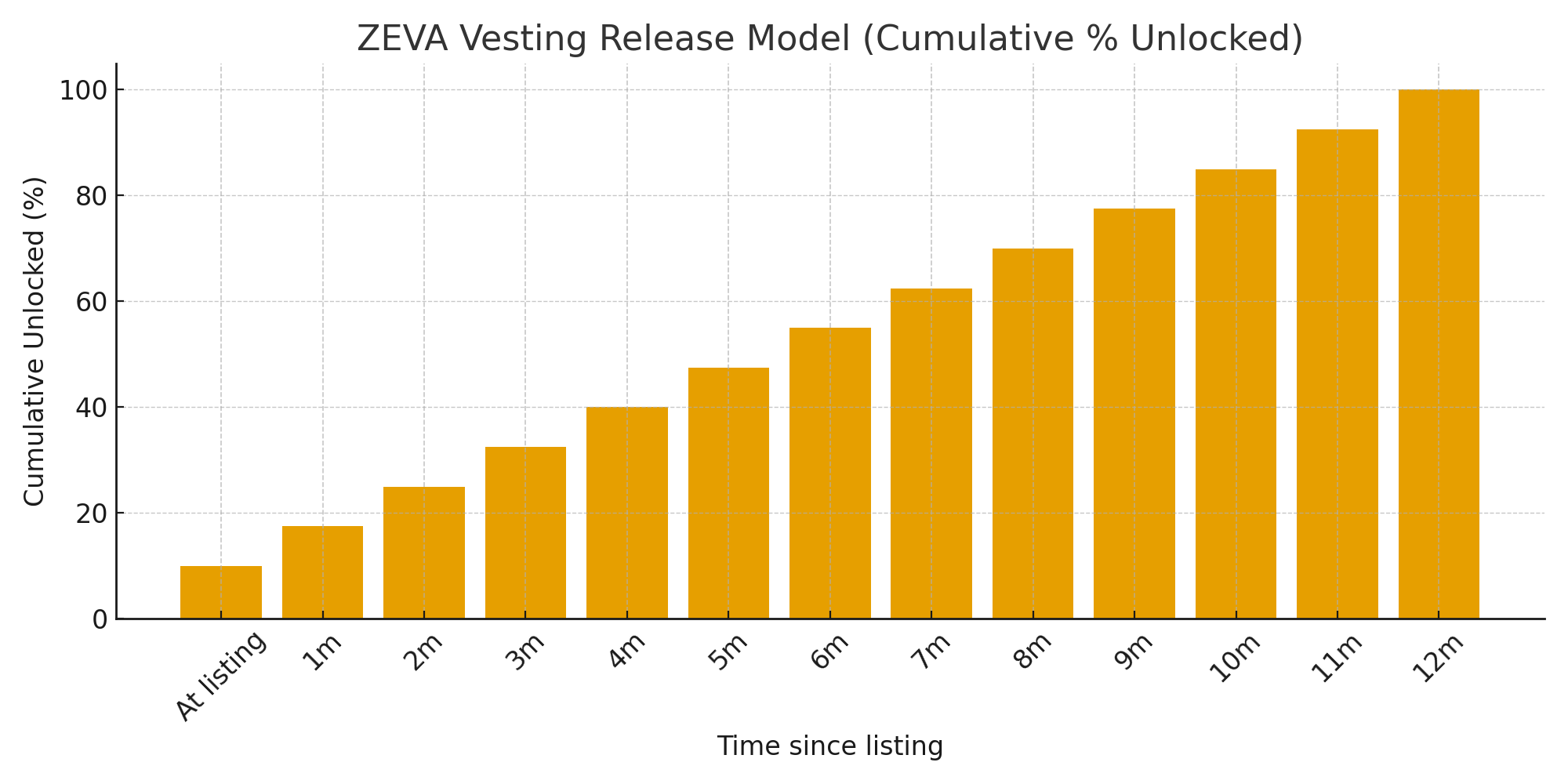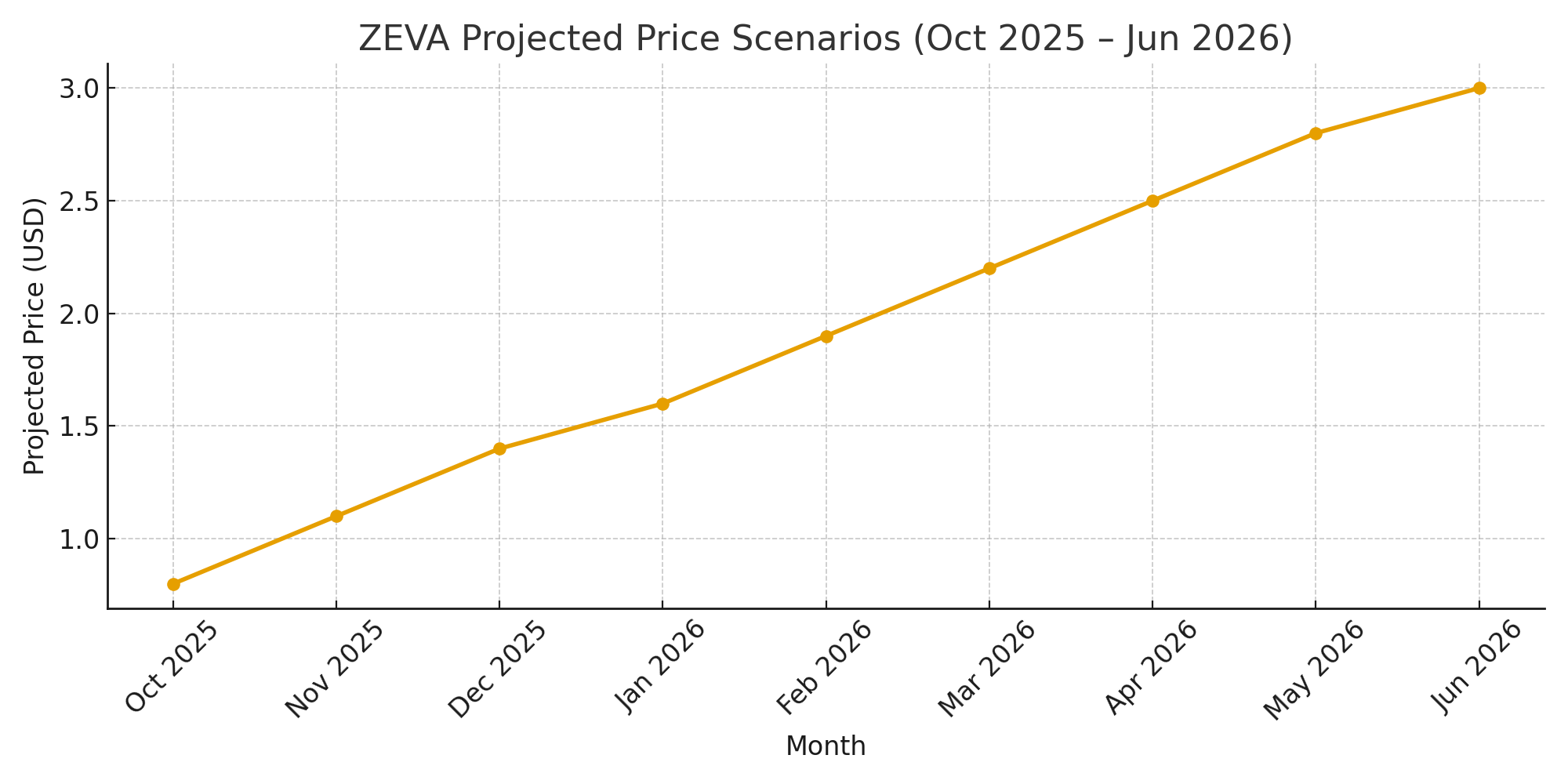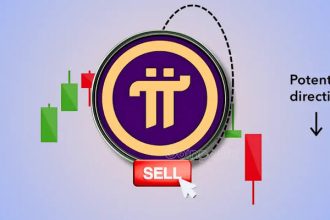The ZEVA token ($ZEVA) is scheduled for listing on September 30, 2025. The ZEVA team and the hosting exchange have announced a set of controls — including a roughly 90% vesting scheme and a temporary deposit cap of 5,000 tokens per user — designed to limit immediate sell pressure and encourage orderly price discovery. This article explores the listing mechanics, token migration rules, vesting schedule, and the implications for investors, task-earners, and the broader ZEVA community.
Why this listing matters
A token’s first major exchange listing is often the moment where theoretical value is tested by real-world trading. For ZEVA, the listing marks a transition from internal distribution and task-based rewards toward a tradable asset with market-driven pricing. How the launch is managed could shape ZEVA’s market reputation for months — and possibly years — to come.
Key announcements at a glance
- Listing date: September 30, 2025.
- Vesting: ~90% of tokens are subject to vesting to control supply.
- Deposit cap: Exchange-mandated limit of 5,000 $ZEVA per user at deposit (subject to change).
- Migration: Pre-sale tokens already in slush wallets; earned tokens migrate after listing.
Background: ZEVA’s token distribution model
ZEVA’s distribution blends pre-sale allocations for early investors with a large community-driven reward system. Users have been able to earn tokens by completing tasks, participating in the ZEVA Play DApp, and contributing to community growth. This hybrid model aims to reward both capital and participation. It also creates different token-holder categories, each with distinct incentives — and risks — during a listing event.
The 90% vesting policy: design and rationale
To prevent immediate post-listing dumping — a common issue for many new tokens — ZEVA’s strategy locks the majority of tokens behind a vesting schedule. In practical terms, this means that only a small portion of the total circulating supply will be immediately available for trading, with the balance released progressively.
This approach serves several purposes:
- Stabilize price discovery: With less supply available at listing, the market has room to find a sustainable price without being flooded.
- Align incentives: Long-term holders and builders are rewarded for patience as the project matures.
- Manage reputation risk: Early extreme volatility can damage long-term credibility; vesting helps avoid this.
Infographic — Vesting release model

Exchange deposit cap: what 5,000 ZEVA means
The hosting exchange’s temporary deposit cap of 5,000 ZEVA per user is a notable control intended to avoid concentration and sudden large sell-offs. While it may frustrate whales or heavy traders in the short term, it is intended to preserve orderly markets and allow liquidity to build over time. Importantly, the exchange has indicated this limit is subject to revision as trading activity matures through 2026.
Token migration: pre-sale vs earned tokens
Token migration is a core element of ZEVA’s launch playbook:
- Pre-sale buyers: These tokens have been migrated to a designated slush wallet prior to listing. Slush wallets are commonly used to securely hold tokens until release conditions are met.
- Task earners: Users who earned tokens through tasks or platform participation will see their tokens migrated after the listing date. This phase-based migration reduces the risk that newly earned tokens flood the market on day one.

Why migrate earned tokens after listing?
Delaying migration for task-earned tokens aims to temper selling pressure from users who may be tempted to cash out immediately. Many task earners may be non-professional traders; giving the market time to absorb supply helps protect token value and rewards longer-term participation.
Projected market dynamics (Oct 2025 – Jun 2026)
While exact pricing is speculative, a controlled release combined with deposit caps suggests a measured liquidity ramp. Below is a sample projection designed to illustrate how measured supply release could coincide with gradual price discovery.

Benefits of a controlled listing
The ZEVA team’s framework offers several benefits for the token’s early market health:
- Reduced dump risk: Vesting and deposit caps help prevent sharp downward pressure caused by large immediate sell-offs.
- Improved investor confidence: By signalling a commitment to orderly markets, ZEVA may attract more institutional or longer-term retail interest.
- Fair access over time: Phased migration allows different holder categories to access markets in a staggered manner.
Potential downsides and practical risks
No strategy is without trade-offs. Key risks and concerns include:
- Liquidity constraints: Tight deposit limits can slow initial market activity, potentially leading to wider spreads and lower volume.
- User frustration: Task earners and smaller holders may feel unfairly restricted if access is delayed without clear timelines.
- Secondary market behaviour: Overly restrictive primary-market rules may push some trading into OTC or secondary venues where price discovery is less transparent.
- Execution risk: The mechanics of migratory transfers and vesting enforcement must be flawless to maintain trust.
How to interpret these limits as an investor
If you are considering participating, here’s a pragmatic checklist:
- Verify the exchange’s official announcement regarding deposit caps and vesting schedules.
- Understand which category your tokens fall into (pre-sale, earned, future rewards).
- Expect low initial liquidity and plan order sizes accordingly — avoid market orders if depth is shallow.
- Keep an eye on official ZEVA channels for governance updates and release milestones.
Community sentiment and reactions
Reactions across ZEVA communities have been mixed. Many applaud the team’s focus on stability; others express impatience over access delays. In public forums, common requests include a clearly published vesting timetable, transparency on slush wallet controls, and a roadmap that ties token releases to measurable product milestones (e.g., dApp launches, marketplace integrations).
Comparisons with past token launches
History offers instructive examples: several projects that experienced early crashes did so because tokens were distributed without adequate lockups or market safeguards. Conversely, projects that instituted sensible vesting schedules and staged exchange access often avoided extreme volatility and built healthier ecosystems. ZEVA’s approach aligns more with the latter playbook.
Looking ahead: what to watch for in 2026
Key indicators of ZEVA’s health over the next 6–12 months include:
- Exchange behaviour: Will the hosting exchange raise deposit caps as liquidity increases?
- On-chain metrics: Transaction volume, active wallets, and dApp adoption will be critical.
- Governance updates: Any changes to vesting or release schedules should be announced transparently and with community input.
- Secondary listings: Additional exchange listings typically improve liquidity and market access.
Practical guidance for different holder groups
Pre-sale buyers
Pre-sale buyers should confirm where their slush-wallet tokens are held and the precise conditions for unlocking. Given that these tokens were migrated earlier immediately after users placed their orders, owners should also verify KYC/withdrawal steps on the exchange to ensure smooth transfers once limits are adjusted.
Task earners
Task earners should track official migration timelines. Patience is often rewarded in vesting systems — immediate access might be limited, but the long-term objective is value preservation.
New entrants
If you are looking to buy post-listing, start small, monitor order book depth, and be prepared for fluctuating spreads in low-liquidity moments.
Conclusion
The September 30th, 2025 listing of ZEVA marks a pivotal moment in the project’s development. With a 90% vesting policy, exchange deposit caps, and a staged migration plan for tokens earned via tasks, the ZEVA team is prioritizing orderly market entry over rapid monetization. While this strategy may generate short-term friction — particularly for users eager to access their holdings — it promotes a more stable environment for the token to grow sustainably.
Investors, community members, and observers should pay close attention to official vesting schedules, exchange announcements, and on-chain metrics as trading commences. If executed transparently and competently, ZEVA’s measured approach could set a constructive precedent for future community-driven token launches in the region.












